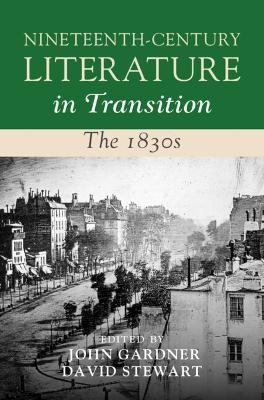
Nineteenth-Century Literature in Transition: The 1830s
Cambridge University Press (Verlag)
978-1-009-26851-6 (ISBN)
This instalment in the Nineteenth-Century Literature in Transition series concerns a decade that was as technologically transitional as it was eventful on a global scale. It collects work from a group of internationally renowned scholars across disciplinary boundaries in order to engage with the wide array of cultural developments that defined the 1830s. Often overlooked as a boundary between the Romantic and Victorian periods, this decade was, the book proposes, the central pivot of the nineteenth century. Far from a time of peaceful reform, it was marked by violent colonial expansion, political resistance, and revolutionary technologies such as the photograph, the expansion of steam power, and the railway that changed the world irreversibly. Contributors explore a flurry of cultural forms to take the pulse of the decade, from Silver Fork fiction to lithography, from working-class periodicals to photographs, and from urban sketches to magazine fiction.
John Gardner is Dean of the Doctoral School and Professor of English Literature at Anglia Ruskin University. Gardner is also the Leverhulme Trust Research Fellow on 'Turning the Screw: Engineering Romanticism', a project which examines convergences between literary and engineering cultures. David Stewart is Associate Professor of English Literature at Northumbria University. He is the author of Romantic Magazines and Metropolitan Literary Culture (2011) and The Form of Poetry in the 1820s and 1830s: A Period of Doubt (2018).
Introduction John Gardner and David Stewart; 1. On the eve: William Benbow, Francis Macerone and the transmission of revolution John Gardner; 2. 'An infectious madness': disability and the epidemiology of social unrest in Dickens's Barnaby Rudge Essaka Joshua; 3. Augustus Hardin Beaumont, slavery apologias, and popular radical literature in the 1830s Tom Scriven; 4. Patterns of industry: Harriet Martineau's illustrated masculinities Valerie Sanders; 5. Mother Earth: gender and geology in the 1830s Adelene Buckland; 6. The polite fictions of slavery: British antislavery in the 1830s Juliet Shields; 7. Suffering, sentiment, and the rise of humanitarian literature in the 1830s Porscha Fermanis; 8. Steam and iron in the 1830s: liberal imperialism, Thomas Love Peacock, and the Nemesi Peter J. Kitson; 9. Lithography and the comic image 1825–1840 Brian Maidment; 10. Jorrocks's canon: Dickens, Surtees and 1830s print culture John Strachan; 11. Tennyson, Dickens, Poe, Browning, and the Brontës: Blackwood's Magazine and 'The foreheads of a new generation' Robert Morrison; 12. Boz in London: The 1830s and the urban turn in the English novel Sambudha Sen; 13. Letitia Elizabeth Landon, chronicler of the 1830s David Stewart; 14. Railway imaginary in the 1830s Nicola Kirkby: finding form; 15. The emerging language of photography Jennifer Green-Lewis; Afterword Richard Cronin.
| Erscheinungsdatum | 25.05.2024 |
|---|---|
| Reihe/Serie | Nineteenth-Century Literature in Transition |
| Zusatzinfo | Worked examples or Exercises |
| Verlagsort | Cambridge |
| Sprache | englisch |
| Maße | 152 x 229 mm |
| Gewicht | 708 g |
| Themenwelt | Geisteswissenschaften ► Sprach- / Literaturwissenschaft ► Anglistik / Amerikanistik |
| Geisteswissenschaften ► Sprach- / Literaturwissenschaft ► Literaturgeschichte | |
| Geisteswissenschaften ► Sprach- / Literaturwissenschaft ► Literaturwissenschaft | |
| ISBN-10 | 1-009-26851-1 / 1009268511 |
| ISBN-13 | 978-1-009-26851-6 / 9781009268516 |
| Zustand | Neuware |
| Haben Sie eine Frage zum Produkt? |
aus dem Bereich


